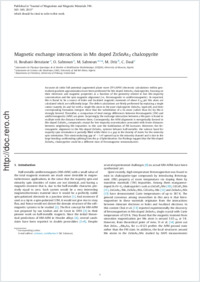Magnetic exchange interactions in Mn doped ZnSnAs₂ chalcopyrite
- Bouhani-Benziane, H. Laboratoire de Physique Quantique de la Matière et Modélisation Mathématique (LPQ3M), University of Mascara, Algeria
- Sahnoun, Omar Laboratoire de Physique Quantique de la Matière et Modélisation Mathématique (LPQ3M), University of Mascara, Algeria
- Sahnoun, Mohammed Laboratoire de Physique Quantique de la Matière et Modélisation Mathématique (LPQ3M), University of Mascara, Algeria - Department of Chemistry, University of Fribourg, Switzerland
- Driz, Mohamed Laboratoire de Sciences des Matériaux (LSM), University of Sidi Bel Abbes, Algeria
- Daul, Claude Department of Chemistry, University of Fribourg, Switzerland
-
15.12.2015
Published in:
- Journal of Magnetism and Magnetic Materials. - 2015, vol. 396, p. 345–349
English
Accurate ab initio full-potential augmented plane wave (FP-LAPW) electronic calculations within generalized gradient approximation have been performed for Mn doped ZnSnAs₂ chalcopyrites, focusing on their electronic and magnetic properties as a function of the geometry related to low Mn-impurity concentration and the spin magnetic alignment (i.e., ferromagnetic vs antiferromagnetic). As expected, Mn is found to be a source of holes and localized magnetic moments of about 4 µB per Mn atom are calculated which are sufficiently large. The defect calculations are firstly performed by replacing a single cation (namely Zn and Sn) with a single Mn atom in the pure chalcopyrite ZnSnAs₂ supercell, and their corresponding formation energies show that the substitution of a Sn atom (rather than Zn) by Mn is strongly favored. Thereafter, a comparison of total energy differences between ferromagnetic (FM) and antiferromagnetic (AFM) are given. Surprisingly, the exchange interaction between a Mn pairs is found to oscillate with the distance between them. Consequently, the AFM alignment is energetically favored in Mn-doped ZnSnAs₂ compounds, except for low impurity concentration associated with lower distances between neighboring Mn impurities, in this case the stabilization of FM increases. Moreover, the ferromagnetic alignment in the Mn-doped ZnSnAs₂ systems behaves half-metallic; the valence band for majority spin orientation is partially filled while there is a gap in the density of states for the minority spin orientation. This semiconducting gap of ~1 eV opened up in the minority channel and is due to the large bonding–antibonding splitting from the p–d hybridization. Our findings suggest that the Mn-doped ZnSnAs₂ chalcopyrites could be a different class of ferromagnetic semiconductors.
- Faculty
- Faculté des sciences et de médecine
- Department
- Département de Chimie
- Language
-
- English
- Classification
- Chemistry
- License
-
License undefined
- Identifiers
-
- RERO DOC 257928
- DOI 10.1016/j.jmmm.2015.08.025
- Persistent URL
- https://folia.unifr.ch/unifr/documents/304757
Statistics
Document views: 98
File downloads:
- pdf: 207
